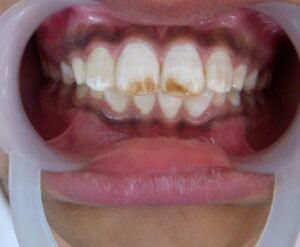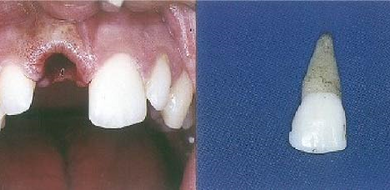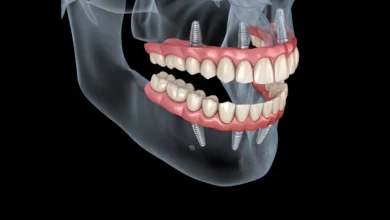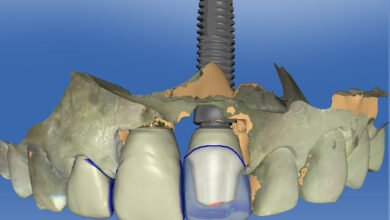
Other Authors:
- Obaid Garouachi
- Rym Masmoudi
- Hend Ouertani
- Mohammed Bassem Khattech
Affiliation: The Principal Military Hospital of Instruction of Tunis, Tunisia
Key Words: Teeth dyschromia, dental fluorosis, bleaching, adhesive dentistry, ceramic veneers
Introduction:
Dental fluorosis, a common aesthetic disorder, results from excessive fluoride intake during tooth development. The clinical manifestations, classified by the Thylstrup and Fejerskov index, can range from mild white or brown spots to more severe conditions such as enamel hypoplasia and increased susceptibility to caries. Beyond the physical effects, the unsightly appearance of affected teeth can lead to significant psychological distress for patients.
Observation:
This case series aims to present a variety of treatment approaches for managing dental fluorosis, from conservative methods such as microabrasion and bleaching to more complex prosthetic options, including lithium disilicate veneers and zirconia crowns. Three clinical cases are discussed in detail, where all patients presented with the chief complaint of an “unpleasant smile due to teeth discoloration.” A thorough dental and medical history revealed that discoloration had been present since childhood, often with similar patterns seen among family members. All patients were from Tunisian regions (Kairouan and Gafsa), known for high concentrations of fluoride in their tap water.
Discussion:
The rehabilitation of dental fluorosis remains a significant challenge in clinical practice, as there are no standardized guidelines for treatment. Accurate diagnosis is crucial, and the choice of therapy should adhere to a therapeutic gradient that respects the severity of the condition. Conservative approaches such as bleaching and microabrasion should be prioritized, as they preserve tooth structure while providing significant aesthetic improvement. In cases of moderate fluorosis, a combination of these techniques may be necessary. However, for more severe cases, prosthetic rehabilitation may be required. All-ceramic veneers and full-coverage crowns offer effective solutions for restoring both aesthetics and function in these cases. Treatment decisions must be based on the severity of fluorosis, patient aesthetic desires, and functional needs. A comprehensive treatment plan, incorporating both functional and aesthetic considerations, is essential for achieving optimal outcomes. Successful rehabilitation not only improves dental appearance but also boosts patient confidence and social well-being.
Biography:
Dr. Ines Azouzi is a highly experienced dental professional with a specialization in Fixed Prosthodontics. She holds a Doctor of Dental Medicine (DMD) degree, awarded in 2014 from the Faculty of Dental Medicine at Monastir University, Tunisia. Dr. Azouzi furthered her expertise by obtaining a specialty in Fixed Prosthodontics in 2018. Currently, she serves as an Associate Professor and the Head of the Fixed Prosthodontics Unit at the Dental Medicine Department of the Principal Military Hospital of Instruction in Tunis, Tunisia.
Her career is distinguished by her commitment to education, research, and clinical excellence. Dr. Azouzi has earned several Certificates of Complementary Studies in areas such as Research Methodology, Pedagogy of Medical Sciences, and Implantology. She is an active participant in both national and international dental congresses and has contributed to the academic community through multiple published scientific articles.
#DentalFluorosis #FluorosisManagement #AestheticDentistry #CosmeticDentistry #DentalProsthetics #ProstheticRehabilitation #RestorativeDentistry #SmileDesign #DentalVeneers #DentalCrowns #FixedProsthesis #RemovableProsthesis #DentalDiscoloration #EnamelHypomineralization #EnamelDefects #FluorosisTreatment #DentalEsthetics #FunctionalDentistry #Prosthodontics #DentalBleaching #MinimallyInvasiveDentistry #RestorativeProtocols #ProstheticSolutions #EstheticProsthodontics #OralRehabilitation #ToothRestoration #EnamelHypoplasia #DiscolorationCorrection #AestheticChallenges #ProstheticChallenges #PatientSatisfactionDentistry #ClinicalDentistry #DentalCaseManagement #ConservativeDentistry #ProstheticPlanning #DentalMaterials #DentalCeramics #ZirconiaCrowns #PorcelainVeneers #CompositeVeneers #DentalBonding #DentalLaminates #AdvancedProsthodontics #FunctionalRehabilitation #SmileMakeover #EstheticManagement #ProsthodonticDilemma #CosmeticDentalTreatment #FluorosisEstheticSolution #ProstheticRestoration
Upcoming Conference:
4th International Dental Advanced Dentistry, and Oral Health UCG Congress | September 9–11, 2025 | Novotel Al Barsha, Dubai, UAE




